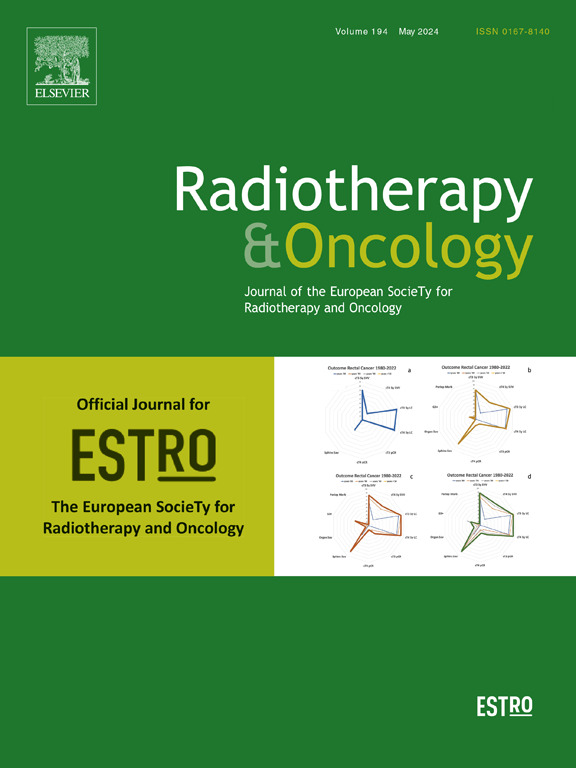Prostate-specific antigen kinetics after stereotactic body radiotherapy for localized prostate cancer: A scoping review and meta-analysis
IF 4.9
1区 医学
Q1 ONCOLOGY
引用次数: 0
Abstract
Purpose
Stereotactic body radiotherapy (SBRT) is emerging as a valuable treatment modality for localized prostate cancer, with promising biochemical progression-free survival rates. Longitudinal assessment of prostate-specific antigen (PSA) is the mainstay of follow-up after treatment. PSA kinetics and dynamics are well-established in the context of brachytherapy and conventionally fractionated radiotherapy, yet little is known in the context of prostate SBRT.
Methods
A review of available literature in MEDLINE, Scopus, and Embase was performed, focusing on studies reporting PSA slope, nadir, bounce, and biochemical failure after prostate SBRT.
Results
Thirty-three records (45 % prospective) encompassing 9949 patients were included. SBRT dose ranged from 32–50 Gy in 4–5 fractions and overall median follow-up time (range) was 41 (15–74) months. Use of androgen deprivation therapy ranged from 0–38 %. SBRT was characterized by a steep initial decline of PSA, slowing down over time and ultimately yielding a lower nadir in comparison with conventional radiotherapy, with a median value (range) of 0.24 (0.1–0.6) ng/mL after a median time (range) of 33.1 (6–54) months. There was an inverse correlation between the highest SBRT dose in a trial and PSA nadir (r = − 0.59; p < 0.001). Benign PSA bounce occurred in 30 % of patients across all studies, after a median time (range) of 14.8 (9–36) months and with a median size (range) of 0.5 (0.3–1.1) ng/mL. There was no significant correlation between bounce and dose, nadir nor biochemical failure. There was, however, a significant inverse correlation between ADT use and PSA bounce frequency (r = −0.49; p = 0.046).
Conclusion
PSA kinetics and dynamics after SBRT for localized prostate cancer are different from those in other established radiotherapy modalities. Benign PSA bounce is very common. Clinicians should be aware of these factors and patients should be counseled accordingly, preventing unnecessary distress or salvage treatment.
局部前列腺癌立体定向体放射治疗后的前列腺特异性抗原动力学:范围综述和荟萃分析。
目的:立体定向体放射治疗(SBRT)正在成为一种治疗局部前列腺癌的重要方法,其无生化进展生存率很高。前列腺特异性抗原(PSA)的纵向评估是治疗后随访的主要方法。近距离放射治疗和传统分次放射治疗中的 PSA 动力学和动态已得到充分证实,但前列腺 SBRT 的相关研究却知之甚少:方法:对MEDLINE、Scopus和Embase中的现有文献进行了回顾,重点关注报告前列腺SBRT后PSA的斜率、最低点、反弹和生化失败的研究:结果:共纳入33项研究(45%为前瞻性研究),涵盖9949名患者。SBRT剂量为32-50 Gy,分4-5次进行,总体中位随访时间(范围)为41(15-74)个月。使用雄激素剥夺疗法的比例为 0-38%。与传统放疗相比,SBRT的特点是PSA最初急剧下降,随着时间的推移逐渐放缓,最终达到较低的低点,中位值(范围)为0.24(0.1-0.6)纳克/毫升,中位时间(范围)为33.1(6-54)个月。在一项试验中,SBRT 的最高剂量与 PSA 最低值呈反向相关(r = - 0.59;p 结论:PSA 的动力学和动态变化与 SBRT 的最高剂量呈反向相关:局部前列腺癌 SBRT 治疗后的 PSA 动力学和动态变化与其他成熟的放疗方式不同。良性 PSA 反弹非常常见。临床医生应了解这些因素,并对患者进行相应的指导,以避免不必要的痛苦或挽救治疗。
本文章由计算机程序翻译,如有差异,请以英文原文为准。
求助全文
约1分钟内获得全文
求助全文
来源期刊

Radiotherapy and Oncology
医学-核医学
CiteScore
10.30
自引率
10.50%
发文量
2445
审稿时长
45 days
期刊介绍:
Radiotherapy and Oncology publishes papers describing original research as well as review articles. It covers areas of interest relating to radiation oncology. This includes: clinical radiotherapy, combined modality treatment, translational studies, epidemiological outcomes, imaging, dosimetry, and radiation therapy planning, experimental work in radiobiology, chemobiology, hyperthermia and tumour biology, as well as data science in radiation oncology and physics aspects relevant to oncology.Papers on more general aspects of interest to the radiation oncologist including chemotherapy, surgery and immunology are also published.
 求助内容:
求助内容: 应助结果提醒方式:
应助结果提醒方式:


